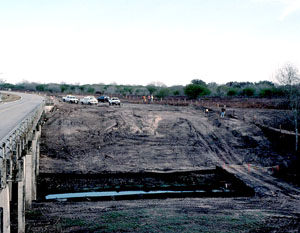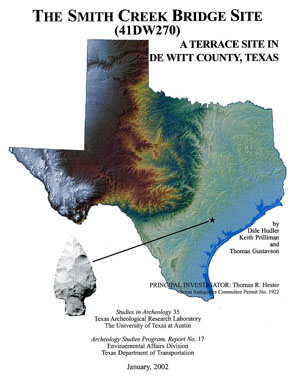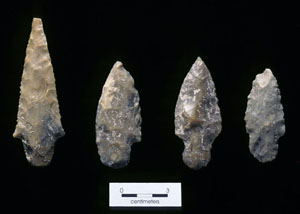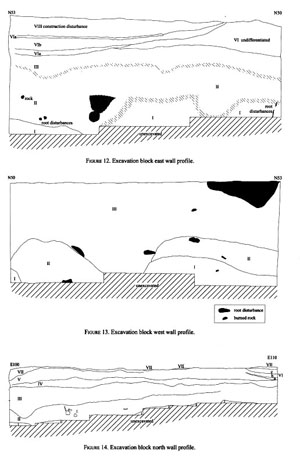Smith Creek Bridge
The Smith Creek Bridge site (41DW270) in southeastern DeWitt County was discovered in 1997 by local archeological steward (of the Texas Historical Commission), E.H. "Smitty" Schmiedlin, during construction of a bridge on State Highway 119, just south of the town of Yorktown. Testing at the site showed that it contained deposits significant enough to halt construction for a period of five weeks so that archeologists could conduct an emergency excavation. Archeologists from the Texas Archeological Research Laboratory (TARL) led the analysis of the site’s deposits as part of one of that organization’s last Cultural Resource Management (CRM) contracts.
The vast majority of artifacts recovered from the site date to the Middle and Late Archaic periods including dart points, bifacial knives, flake tools, cores and ground stone tools as well as chert débitage from stone tool manufacture. The most notable component preserved at the site contains material used by groups carrying Morhiss projectile points during the Late Archaic, around 800 B.C. The Morhiss component, named for the Morhiss Mound site where the dart point style was first identified, was selected for intensive analysis and the animal remains and stone tools recovered yielded a great deal of information about these groups.
The wide range of animal remains recovered from the Morhiss component at the site include deer, rabbit, lizards, snakes, turtles, fish and mussels. This diversity led archeologists to conclude that Morhiss groups were “broad spectrum” foragers who did not focus on the hunting of one particular resource such as bison. Some of the animal remains also helped archeologists determine when these foraging groups occupied the site. Remains of fish and mussels along with some evidence from bison remains indicate that groups occupied the site year round, perhaps focusing on fish such as large-mouth bass during the fall and winter.
The stone tools found in the Morhiss component also helped to shed light on the people who occupied the site during this time. Many of the stone tools from this component, such as bifaces and flake tools, are believed to represent “general use” tools that could be adapted to a number of tasks. Likewise, there is evidence that Morhiss projectile points were also used as knives. This technological flexibility is further evidence of a broad-based subsistence strategy on the part of Morhiss groups.
The Smith Creek Bridge site report represents what is best about CRM archeology. Archeologists worked tirelessly throughout the holiday season of 1997 to save the site’s materials from destruction and their efforts were rewarded by a multi-disciplinary analysis that shed a great deal of light on the lifeways of the prehistoric occupants of the site.
Contributed by Jeff Taff.
Source
Hudler, Dale, Keith Prilliman and Thomas Gustavson
2002 The Smith Creek Bridge Site (41DW270): A Terrace Site in DeWitt
County, Texas. Studies in Archeology 35, Texas Archeological
Research Laboratory, Austin.



